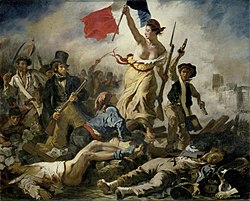Series of revolutions occurring in various locations within a similar time span
A revolutionary wave (sometimes revolutionary decade) is a series of revolutions occurring in various locations within a particular timespan. In many cases, past revolutions and revolutionary waves have inspired current ones, or an initial revolution has inspired other concurrent "affiliate revolutions" with similar aims.[1][2]
The causes of revolutionary waves have become the subjects of study by historians and political philosophers, including Robert Roswell Palmer, Crane Brinton, Hannah Arendt, Eric Hoffer, and Jacques Godechot.[3]
Writers and activists, including Justin Raimondo and Michael Lind, have used the phrase "revolutionary wave" to describe discrete revolutions happening within a short time-span.[4][5][6]
Typology
Mark N. Katz[7] identified six forms of revolution;
- rural revolution
- urban revolution
- Coup d'état, e.g. Egypt, 1952
- revolution from above, e.g. Mao's Great Leap Forward of 1958
- revolution from without, e.g. the allied invasions of Italy, 1944 and Germany, 1945.
- revolution by osmosis, e.g. the gradual Islamization of several countries.
These categories are not mutually exclusive; the Russian revolution of 1917 began with urban revolution to depose the Czar, followed by rural revolution, followed by the Bolshevik coup in November. Katz also cross-classified revolutions as follows;
- Central; countries, usually Great powers, which play a leading role in a Revolutionary wave; e.g. the USSR, Nazi Germany, Iran since 1979.[8]
- Aspiring revolutions, which follow the Central revolution
- subordinate or puppet revolutions
- rival revolutions, e.g. communist Yugoslavia, and China after 1969
Central and subordinate revolutions may support each other militarily, as for example the USSR, Cuba, Angola, Ethiopia, Nicaragua and other Marxist regimes did in the 1970s and 1980s.[9]
A further dimension to Katz's typology[10] is that revolutions are either against (anti-monarchy, anti-dictatorial, anti-capitalist, anti-communist, anti-democratic) or for (pro-fascism, pro-liberalism, pro-communism, pro-nationalism etc.). In the latter cases, a transition period is often necessary to decide on the direction taken.
Periodisation
There is no consensus on a complete list of revolutionary waves. In particular, scholars disagree on how similar the ideologies of different events should be in order for them to be grouped as part of a single wave, and over what period a wave can be considered to be taking place – for example, Mark N. Katz discussed a "Marxist-Leninist wave" lasting from 1917 to 1991, and a "fascist wave" from 1922 to 1945, but limits an "anti-communist wave" to just the 1989 to 1991 period.[11]
In Marxism
Marxists see revolutionary waves as evidence that a world revolution is possible. For Rosa Luxemburg, "The most precious thing… in the sharp ebb and flow of the revolutionary waves is the proletariat's spiritual growth. The advance, by leaps and bounds, of the intellectual stature of the proletariat affords an inviolable guarantee of its further progress in the inevitable economic and political struggles ahead."[21] The need for a world-wide socialist revolutionary wave for the survival of a socialist state has and continues to be a topic of controversy between Marxists, most notably between Trotskyists and mainline Marxist-Leninist.[22]
Potential revolutionary waves
Mark Katz theorises that Buddhism (in Sri Lanka, Thailand, Indochina, Burma, Tibet) and Confucianism (to replace Marxism in China and promote unity with Chinese in Taiwan, Hong Kong, Singapore, Malaysia) might be the revolutionary waves of the future. In the past, these religions have been passively acquiescent to secular authority; but so was Islam, until recently.[23]
Katz also suggests that nationalisms such as Pan-Turanianism (in Turkey, Central Asia, Xinjiang, parts of Russia), 'Pan-native Americanism' (in Ecuador, Peru, Bolivia, Paraguay) and Pan-Slavism (in Russia, Ukraine, Belarus) could also form revolutionary waves.[24]


